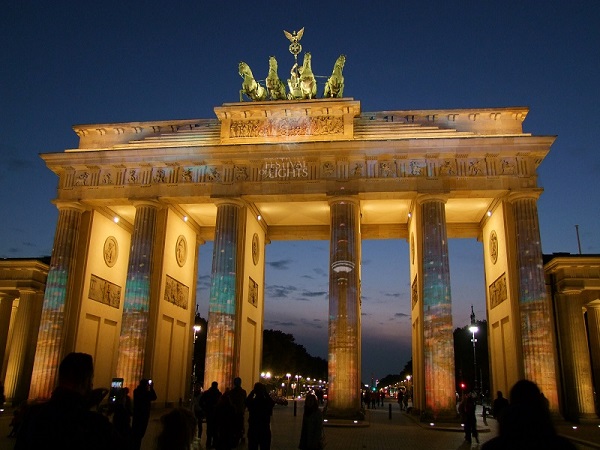
While Tegel airport in Berlin does not emit the same nostalgic aura as Templehof - particularly from its prominence during the Cold War era - it is a modern example of German efficiency and offers a delightful welcome to the most intriguing of German cities when flown there by Luxair.
The early morning Luxair flight on Monday allowed a view over the expanse of German landscape, breaking only for evidence of industrial output and vast residential areas. The flight offered a wonderful red horizon under a ruch blue sky until the blood-red sun rose to greet us; on descending to land, a myriad of green expanses and waterways came into view offering a taste of what we could expect by way of the ground-level geography.
As a lasting symbol of East-meets-West, including the former wave of communism meeting the capitalism of western Europe, Berlin continues to evolve yet harbour reminders of times past, not least from the Cold War. On the one hand it is a city-wide innovation hub whose creativity and ingenuity is the envy of all of Germany and further afield; on the other, the likes of Checkpoint Charlie and the Brandenburg Gate are bastions to a former age.
The Berlin Wall stretched 166km around Berlin, was erected in 1961 and came down in 1989, with reunification in 1990.
It is now a quarter of a century since the 166km-long Berlin Wall came down (in 1989; it was erected in 1961) and reunification (in 1990) became a word used the world over to describe the historical changing of the political landscape; many of us remember those seismic moments as history unfurled on our television screens before us. The Internet was not yet in its infancy so there were no selfies or self-styled bloggers broadcasting instantaneously across the world, but history was indeed in the making. Now, 25 years on, Berlin is forging ahead while keeping tabs in the past.
Knut, the world-famous polar bear may not be any more, but Berlin Zoo has not lost any of its allure; while the Victorian way of bringing nature to us has long dissipated due to the emergence of the Internet and travel becoming ever easier, as well as animal-rights campaigners having their say, such venues still offer an insight into the lives of animals and plants that books and LCD displays cannot, and Berlin Zoo stands tall at the top if this list.
The German city, now a long time rid of its American, British, French and Russian quarters, offers wide tree-lined streets with monuments and statues dotted around the place, with memorials too, evoking memories back to the time of the 3rd Reich, the persecution of the Jews and beforehand to the French Hugeneots, and more. The tour guide we had spent a lot of time and effort explaining the difference in architectural styles since the Reunification and Berlin becoming Germany's capital - the hodge podge of architectural styles is striking and the hidden courtyards behind fascinating; they are still rebuilding after WWII and reunification. The bus tour, with parts on foot, also took in the new political quarter and the Brandenburger Gate which dates from the 18th century and, later in the 19th century, Napoleon, and the restoration of the Pariser Platz after reunification.
All in all, Berlin has a huge amount of history and cultural heritage waiting to be discovered - to help, VisitBerlin has put together a Berlin Welcome Card which, from €19.50 for 2 days, allows discounted (25%-50%) access to museums and other tourist sites across the city (+ €2 to include Potsdam); it also offers free public transport in the city.
But Berlin has much, much more to offer in addition to stories of the past. There is the Rosenhofe artistic quarter to explore including the original Ampelmann shop. And another way to get around is by bicycle. We took a bicycle tour, courtesy of Berlin on Bike (BOB); the tour guide was a mine of information, explaining the growth of the city historically and the different neighbourhoods and architecture, describing the reasoning behind the different heights of the two walls - to trap those fleeing from the East and for photographs from the West showing just low walls...
The expansive network of Cycle Lanes on the roads and pavements throughout the city - as well as there being very few inclines - make this an ideal way to see the sights, many of which are hidden away from the main tourisic spots. In reality, there is much more stopping than cycling, but the success of such excursions are "make or break" according to the personality of the guide - we were extremely lucky; he told us anecdotes involving his own family and the scars that remain to this day, as well as many not-so-public accounts involving the people of Berlin themselves, and also some stories in the general public realm.
We also came across the site of The House of One, a construction of a 3-in-1 religious building encompassing Jews, Muslems and Christians; another example of looking forward while learning from the past. Another discovery was the small area of squats from which the (East) German punk band Rammstein originated. Stopping by Checkpoint Charlie was another item checked off the list of things to do; we did see some of the other former checkpoint locations too. With Berlin being home to many, many museums and galleries, the one that tops my list is the Checkpoint Charlie museum itself: set in three adjoining buildings, one is led along a specific path, discovering the stories behind many of the escapes, from tunnels and secret compartments in cars to airborne escapes, etc. - an incredible legacy to remind us of the desperate measures people went to in order to cross (under, over or through) the wall. My #2 museum experience ever!
One dinner was at the Clärchens Ballhaus, nicknamed the Gypsy Restaurant, in an old-fashioned music / dance hall, a building which is thought to originate from the time of Kaiser Wilhelm II's butler, on Auguststrasse in the Jewish quarter. The building certainly has history and plenty of character - and could do with a lick of paint - even though we were there in the middle of the day without any live band performing, although instruments littered the stage and piped ballroom music filled the air as tasters of what happens there on week-end evenings. The food was primarily traditional fare, with pork medallions, schnitzel, meatballs and goulash among the dishes ordered, all delicious and devoured after a long morning.
Another meal was as the majestic Adlon hotel, a stone's throw from the Brandenburger Gate; a sumptuous offering from a delightful menu, with staff pampering to one's every desire. And, like the rest of Berlin, the cost was surprisingly low, confirming the attrcativeness of the destination.
In the evening, Berlin's Festival of Lights starts at around 19:00 - this spectacle has allowed artists using light, with some displays some supported by music too, to project an artistic creation against various buildings in the city, including the Brandenburger Gate; the festival lasts until Sunday (18 October).
Travel & Accommodation
Thinking of planning a trip to Berlin? Why not do so around one of the many festivals coming up over the next weeks and months? see www.visitberlin.de/en for details.
Berlin in just 600km from the Grand Duchy as the crow flies and can be reached in just 70 minutes courtesy of Luxair and its Bombardier Q400 turbo-props. See www.luxair.lu for timetable and reservations.
We stayed at the Riu Plaza Berlin, close to buses and the ultra-efficient underground; a class hotel in the LuxairTours Metropolis catalogue.
For the full photo album (on Facebook), click https://www.facebook.com/media/set/?set=a.771360496308591.1073741898.238112732966706&type=3.
Photos by Geoff Thompson









